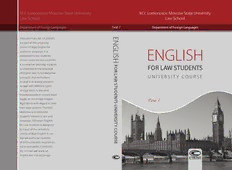
English for Law Students: University Course. Part I PDF
Preview English for Law Students: University Course. Part I
Copyright ОАО «ЦКБ «БИБКОМ» & ООО «Aгентство Kнига-Cервис» M.V. Lomonosov Moscow State University M.V. Lomonosov Moscow State University Law School Law School Department of Foreign Languages Part I Department of Foreign Languages ENGLISH FOR LAW STUDENTS E N is a part of the university course of legal English for G ENGLISH academic purposes. It is L I addressed to law students S of non-common law countries. H It is aimed at teaching students F FOR LAW STUDENTS to understand the language O R of English law, its fundamental L U N I V E R S I T Y C O U R SE concepts and institutions. A W Its goal is to enable students S to deal with different types T U of legal texts, to become D knowledgeable in current legal E N issues, to use proper English T Part I legal terms with regard to their S U own legal systems. The final N objective is to stimulate I V E students’ interest in law and R language. Although English S I T for Law Students is designed Y as a part of the university C O course of legal English it can U also be useful for students R S of the humanities, economics, E social and political sciences, etc. in their self-study of English law and language. Copyright ОАО «ЦКБ «БИБКОМ» & ООО «Aгентство Kнига-Cервис» M.V. Lomonosov Moscow State University Law School Department of Foreign Languages ENGLISH FOR LAW STUDENTS UNIVERSIT Y COURSE Part I ÌÎÑÊÂÀ 2014 Copyright ОАО «ЦКБ «БИБКОМ» & ООО «Aгентство Kнига-Cервис» УДК802/809.1 ББК81.2 E58 EditEdby tatianatarasova CONtRibUtORS: Natalyaberezhneva AsyaGoloborodko dinaKarpova tatianatarasova REViEWEdby EugeniayakovlevaProfessorofLinguistics SurenAvakjanProfessorofLaw E58 English for Law Students:UniversityCourse/Ed.byt.tarasova.Parti.– Moscow:StAtUt,2014.–343p.[Английскийязыкдлястудентов- юристов.–М.:Статут,2014.–Наанглийскомязыке] iSbN978-5-8354-0978-5(Parti;softback) iSbN978-5-8354-0977-8 ENGLiSHFORLAWStUdENtSisapartoftheuniversitycourseof legalEnglishforacademicpurposes.itisaddressedtolawstudentsofnon- commonlawcountries.itisaimedatteachingstudentstounderstandthe languageofEnglishlaw,itsfundamentalconceptsandinstitutions.itsgoal istoenablestudentstodealwithdifferenttypesoflegaltexts,tobecome knowledgeableincurrentlegalissues,touseproperEnglishlegaltermswith regardtotheirownlegalsystems.thefinalobjectiveistostimulatestudents’ interestinlawandlanguage.Although English for Law Studentsisdesigned asapartoftheuniversitycourseoflegalEnglishitcanalsobeusefulfor studentsofthehumanities,economics,socialandpoliticalsciences,etc. intheirself-studyofEnglishlawandlanguage. УДК802/809.1 ББК81.2 iSbN978-5-8354-0978-5(Parti) iSbN978-5-8354-0977-8 ©Contributors,2013 ©Издательство«Статут»(StatutPublishingHouse),2013 Copyright ОАО «ЦКБ «БИБКОМ» & ООО «Aгентство Kнига-Cервис» CONTENTS Foreword.................................................................................................5 UNIT I HISTORY AND SOURCES OF ENGLISH LAW text1.CaseLaw.....................................................................................6 text2. HowdoJudgesReallydecideCases?........................................19 text3.Equity........................................................................................30 UNIT II CONSTITUTION text1.thedevelopmentoftheUKConstitution..................................38 text2. EvolutionofthebritishConstitution inthe17-thCentury...................................................................44 text3.StructureoftheUKConstitution...............................................52 text4.Constitutionalism.......................................................................63 text5.SeparationofPowers..................................................................71 text6.SeparationofPowersintheUnitedKingdom.............................79 text7.theRuleofLaw.........................................................................84 text8.FederalandUnitaryConstitutions.............................................95 UNIT III MONARCHY text1.NatureoftheCrown................................................................107 text2.FunctionsofMonarchy............................................................118 text3.PersonalPowersoftheMonarch..............................................124 text4.theRoyalPrerogative..............................................................136 text5. dwindlingPoweroftheCrown................................................141 text6.ARightRoyalArgument..........................................................147 text7.ReferendumSettobacktheQueenofAustralia........................150 3 Copyright ОАО «ЦКБ «БИБКОМ» & ООО «Aгентство Kнига-Cервис» UNIT IV PARLIAMENT text1.RiseofEnglishParliament.......................................................157 text2.FormationoftwoHousesofParliament..................................162 text3.LegalHistoryofParliament......................................................164 text4.britishParliamenttoday.........................................................172 text5.CompositionofParliament......................................................187 text6. CompositionoftheModernHouseofLords.............................202 text7.CompositionoftheModernHouseofCommons.....................224 text8.MeetingofParliament..............................................................236 text9. typesofLegislation.................................................................240 text10.PassageofaPublicbillintroducedbytheGovernment intotheHouseofCommons...................................................242 text11.ParliamentaryPrivilege..........................................................249 UNIT V THE EXECUTIVE text1.ParliamentaryGovernment......................................................259 text2.CabinetandPrimeMinister.....................................................268 text3. GrowthoftheExecutive...........................................................272 text4. ‘Hollowed-outGovernment’....................................................277 Glossary..............................................................................................291 Keys....................................................................................................326 References...........................................................................................342 Copyright ОАО «ЦКБ «БИБКОМ» & ООО «Aгентство Kнига-Cервис» FOREWORD English for Law Studentsisdesigned • tomeetthestudents’needsinacquiringbothlanguage throughlawandlawthroughlanguage; • tostrengthentheirreadingandwritingskills; • todevelopthestudents’abilitytoanalyse,summeriseand interpretlegaltextsconcerningparticularlegalareaorissue; • tointroducecommonlawterms,conceptsandinstitutions tothestudentsofadifferentlawsystem; • toincreasetheircompetenceinlegallanguageusage; • toprovidethoughtprovokingmaterials; • toencourageanalyticalapproachtoandcomparative studiesofcurrentlegalissuesandreforms; • toequipstudentswithlinguistictoolstoadvanceintheir scholarlyactivity. English for Law StudentscontainsfiveUNitS:Historyand SourcesofEnglishLaw,Constitution,Monarchy,Parliament, theExecutive.Eachunitincludesanumberoftextsona particularthemefollowedbyLANGUAGEPRACtiCEANd COMPREHENSiONCHECKwithtASKSrangingfrom wordbuildingtocomplicatedlegalvocabulary,grammar,syntax, discussionpoints.theyfocusonreadingcomprehension,speaking andwritingactivities.Eachunitendswiththetasktowritean essaybasedonthetextsoftheunitononeoftheexamquestions. theKEyattheendofthebookgivestheanswerstosome exercises. theGLOSSARyprovidesdefinitionsformostlegalterms usedintheunits. English for Law Studentsisdesignedforallthosewhostrive foracademicexcellenceandprofessionalsuccess. Copyright ОАО «ЦКБ «БИБКОМ» & ООО «Aгентство Kнига-Cервис» UNIT I HISTORY AND SOURCES OF ENGLISH LAW tEXt1 CASE LAW thewordsourcecanmeanseveraldifferentthingswithregard tolaw,butforourpurposesitprimarilydescribesthemeansby whichthelawcomesintoexistence. Englishlawstemsfromsevenmainsources,thoughthese varyagreatdealinimportance.thebasisofEnglishlaw todayiscaselaw,amassofjudge-madedecisionswhichlays downrulestobefollowedinfuturecases.Formanycenturies itwasthemainformoflawanditisstillveryimportanttoday. However,themostimportantformoflaw,inthesensethatit prevailsovermostoftheothers,isstatute,orActofParliament, whichtodayisthesourceofmostmajorchangesinthelaw. Aswellasbeingasourceoflawintheirownright,statutes contributetocaselaw,sincethecourtsoccasionallyhave tointerpretstatutoryprovisions,andsuchdecisionslaydown newprecedents.delegatedlegislationisarelatedsource,laying downdetailedrulesmadetoimplementthebroaderprovisions ofstatutes. Anincreasinglyimportantsourceoflawisthelegislationof theEuropeanCommunity,whichistheonlytypeoflawthat cantakeprecedenceoverstatutesintheUK,andisincreasingly influencingthedecisionsofthecourtsininterpretingstatutes. 6 Copyright ОАО «ЦКБ «БИБКОМ» & ООО «Aгентство Kнига-Cервис» HiStORyANdSOURCESOFENGLiSHLAW Finally,custom,equityandobligationsrelatingtointernational treatiesareminorsourcesoflaw,thoughbritain’sobligations undertheEuropeanConventiononHumanRightshave producednotablecontributionstolawreform. beforetheNormanconquest,differentareasofEngland weregovernedbydifferentsystemsoflaw,oftenadaptedfrom thoseofthevariousinvaderswhohadsettledthere;roughly speaking,danelawappliedinthenorth,Mercianlawaround themidlands,andWessexlawinthesouthandwest.Eachwas basedlargelyonlocalcustom,andevenwithinthelargerareas, thesecustoms,andhencethelaw,variedfromplacetoplace. thekinghadlittlecontroloverthecountryasawhole,andthere wasnoeffectivecentralgovernment. WhenWilliamtheConquerorgainedtheEnglishthronein 1066,heestablishedastrongcentralgovernmentandbegan, amongotherthings,tostandardizethelaw.Representatives ofthekingweresentouttothecountrysidetochecklocal administration,andweregiventhejobofadjudicatinginlocal disputes,accordingtolocallaw. Whenthese‘itinerantjustices’returnedtoWestminster,they wereabletodiscussthevariouscustomsofdifferentpartsof thecountryand,byaprocessofsifting,rejectunreasonableones andacceptthosethatseemedrational,toformaconsistentbody ofrules.duringthisprocess–whichwentonforaroundtwo centuries–theprincipleofstare decisis(‘letthedecisionstand’) grewup.Wheneveranewproblemoflawcametobedecided, thedecisionformedaruletobefollowedinallsimilarcases, makingthelawmorepredictable. theresultofallthiswasthatbyabout1250,a‘commonlaw’ hadbeenproduced,thatruledthewholecountry,wouldbe appliedconsistentlyandcouldbeusedtopredictwhatthecourts mightdecideinaparticularcase.itcontainedmanyofwhatare nowbasicpointsofEnglishlaw–thefactthatmurderisacrime, forexample. 7 Copyright ОАО «ЦКБ «БИБКОМ» & ООО «Aгентство Kнига-Cервис» UNiti theprinciplesbehindthis‘commonlaw’arestillusedtoday increatingcaselaw(whichisinfactoftenknownascommon law).Fromthebasicideaofstare decisis,ahierarchyofprecedent grewup,inlinewiththehierarchyofthemoderncourtsystem, sothat,ingeneral,ajudgemustfollowdecisionsmadeincourts whicharehigherupthehierarchythanhisorherown.this processwasmadeeasierbytheestablishmentofaregularsystem ofpublicationofreportsofcasesinthehighercourts.thebody ofdecisionsmadebythehighercourts,whichthelowerones mustrespect,isknownascaselaw. Caselawcomesfromthedecisionsmadebyjudgesinthecases beforethem(thedecisionsofjuriesdonotmakecaselaw).inde- cidingacase,therearetwobasictasks;first,establishingwhat thefactsare,meaningwhatactuallyhappened;andsecondly,how thelawappliestothosefacts.itisthesecondtaskthatcanmake caselaw,andtheideaisthatonceadecisionhasbeenmadeon howthelawappliestoaparticularsetoffacts,similarfactsinlater casesshouldbetreatedinthesameway,followingtheprincipleof stare decisisdescribedabove.thisisobviouslyfairerthanallowing eachjudgetointerpretthelawdifferently,andalsoprovidespre- dictability,whichmakesiteasierforpeopletolivewithinthelaw. thejudgeslistentotheevidenceandthelegalargument andthenprepareawrittendecisionastowhichpartywins, basedonwhattheybelievethefactswere,andhowthelaw appliestothem.thisdecisionisknownasthejudgment, andisusuallylong,containingquitealotofcommentwhich isnotstrictlyrelevanttothecase,aswellasanexplanation ofthelegalprinciplesonwhichthejudgehasmadeadecision. theexplanationofthelegalprinciplesonwhichthedecision ismadeiscalledtheratiodecidendi–Latinforthe‘reasonfor deciding’.itisthispartofthejudgment,knownasbinding precedent,whichformscaselaw.Allthepartsofthejudgment whichdonotformpartoftheratio decidendiofthecaseare calledobiter dicta–whichisLatinfor‘thingssaidbytheway’. 8 Copyright ОАО «ЦКБ «БИБКОМ» & ООО «Aгентство Kнига-Cервис» HiStORyANdSOURCESOFENGLiSHLAW theseareoftendiscussionsofhypotheticalsituations:for example,thejudgemightsay‘Jonesdidthis,butifhehaddone that,mydecisionwouldhavebeen...’Noneoftheobiter dicta formspartofthecaselaw,thoughjudgesinlatercasesmaybe influencedbyit,anditissaidtobeapersuasiveprecedent. LANGUAGE PRACTICE AND COMPREHENSION CHECK ACTIVE VOCABULARY case possiblecrimeanditsinvestigationbythe police court case legalactionorcrime case law lawasestablishedbyprecedents to stem from toderivefrom,tooriginate to lay down todeclareorstartfirmly statute lawpassedbyalawmakingbody to interpret toplaceaparticularmeaningon precedence therighttobeputordealtwithbefore others,especiallybecauseofthegreater importance to take precedence to give precedence to apply the law toeffect;bedirectlyrelated justice 1.fairtreatment(inlaw) 2.magistrate 3.titlegiventoHighCourtjudge itinerant justice travelingjustice evidence theanswersgiveninthecourtoflaw judgment adecisionmadebyacourtinrespectof thematterbeforeit TASK I. a) Complete the following sentences using the above words: 1.thisruledoesnot…toyourparticularcase. 9
